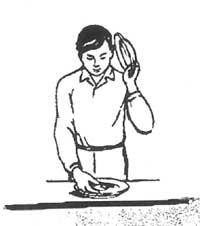An echo use
In the previous workshop we explain what is eco and this time we will make known one of its applications. Although the phenomenon has always been known, for years it has had no use. At the beginning of this century the immense ship called "Titanic" sank, with which almost all passengers sank. The cause of this incident was the crash against an iceberg.

To prevent this from happening and detect ice obstacles at night or on cloudy days, they came up with echoing. The application that occurred to them did not achieve what was intended, but with it developed the idea of measuring the depth through the sound reflected in the seabed.
In the image you can see a scheme of this idea. In part of the submerged boat there is a focus of acoustic waves. The sound waves that come out of the focus go down the water to the bottom, after being reflected here will go up, generating some echo. This echo is assumed by a special apparatus located in the lower part of the ship and a clock system accurately measures the time that elapses between the emission of the acoustic wave and the reception of the echo. If you know the speed of noise in the water, the distance between the boat and the seabed is very easy to calculate.
The echo probe or sonar, so called this system and apparatus, was a real revolution in the field of measuring depths of the seas. For the use of Sonarra's previous systems, the vessel had to remain standing and for a long time: the probe rope was rolled up on a wheel and gradually detached to be collected in the same way for one hundred and fifty meters per minute. Therefore, to measure three kilometers of depth it took forty-five minutes.
With both Sonarra and the boat running, this measurement can be performed in a few seconds and the result obtained is much more accurate and safe. The error of this probing system does not exceed the fourth meter, since it is measured with a time interval accuracy three thousand times less than a second.
Accurate measurement of large depths is very important in oceanographic science and rapid, accurate and safe measurement of depths is of great help for navigation. Sonarra allows, among other things, bringing ships to the coast in an agile and safe way.
The first echo probe was designed by the French physicist Langevin to detect German dives during World War I.
Current sonars do not use the usual sound but "ultrasound". Its frequency is millions of oscillations per second and does not hear human ears.
Acoustic mirrors
Echo is only the result of sound reflection and through these reflections we can perform another curious exercise.
A large wall, building or any obstacle that may reflect noise can be assimilated to a mirror in which sound behaves in the same way that light is reflected in a laun mirror.

Acoustic mirrors can be both laun and spherical. Spherical concavas collect the rays of sound in their focus.
This exercise will be done with two deep dishes and wrist watch. Let us put on a table one of these dishes and on it, several centimeters from the bottom, we hold a wrist watch with our hands. As shown in the picture, bring the other dish closer to the ear. If we get the position the clocks, ears and plates need (after several attempts) we would hear the clock beats. If the eyes are broken, we will not be able to say if we have the clock on the left or right hand side.
The medieval castilleros knew these sound curiosities well and used them in their constructions, for which they placed armor and images in the spotlights of the well disguised concave sonorous mirrors.
Buletina
Bidali zure helbide elektronikoa eta jaso asteroko buletina zure sarrera-ontzian











